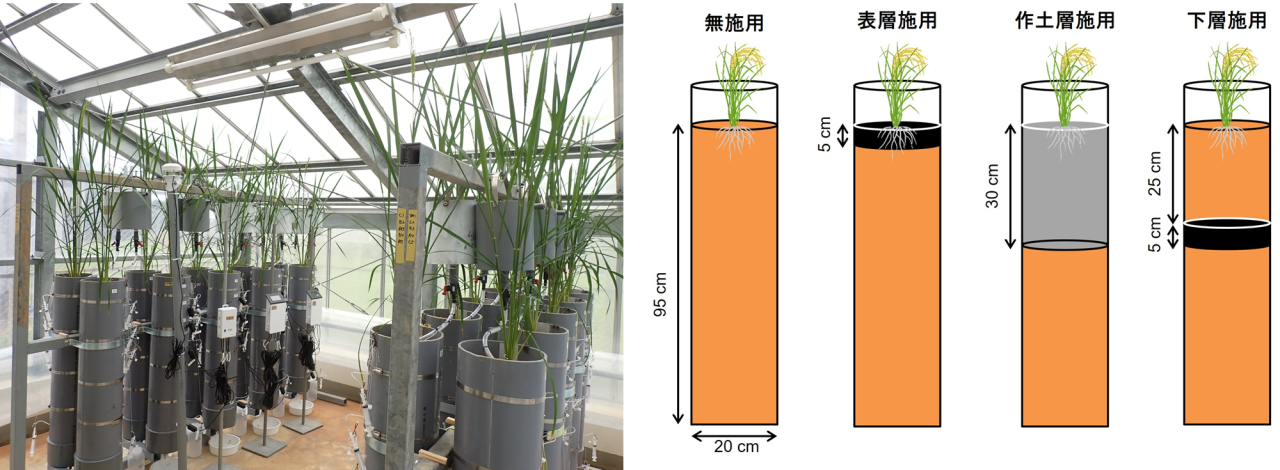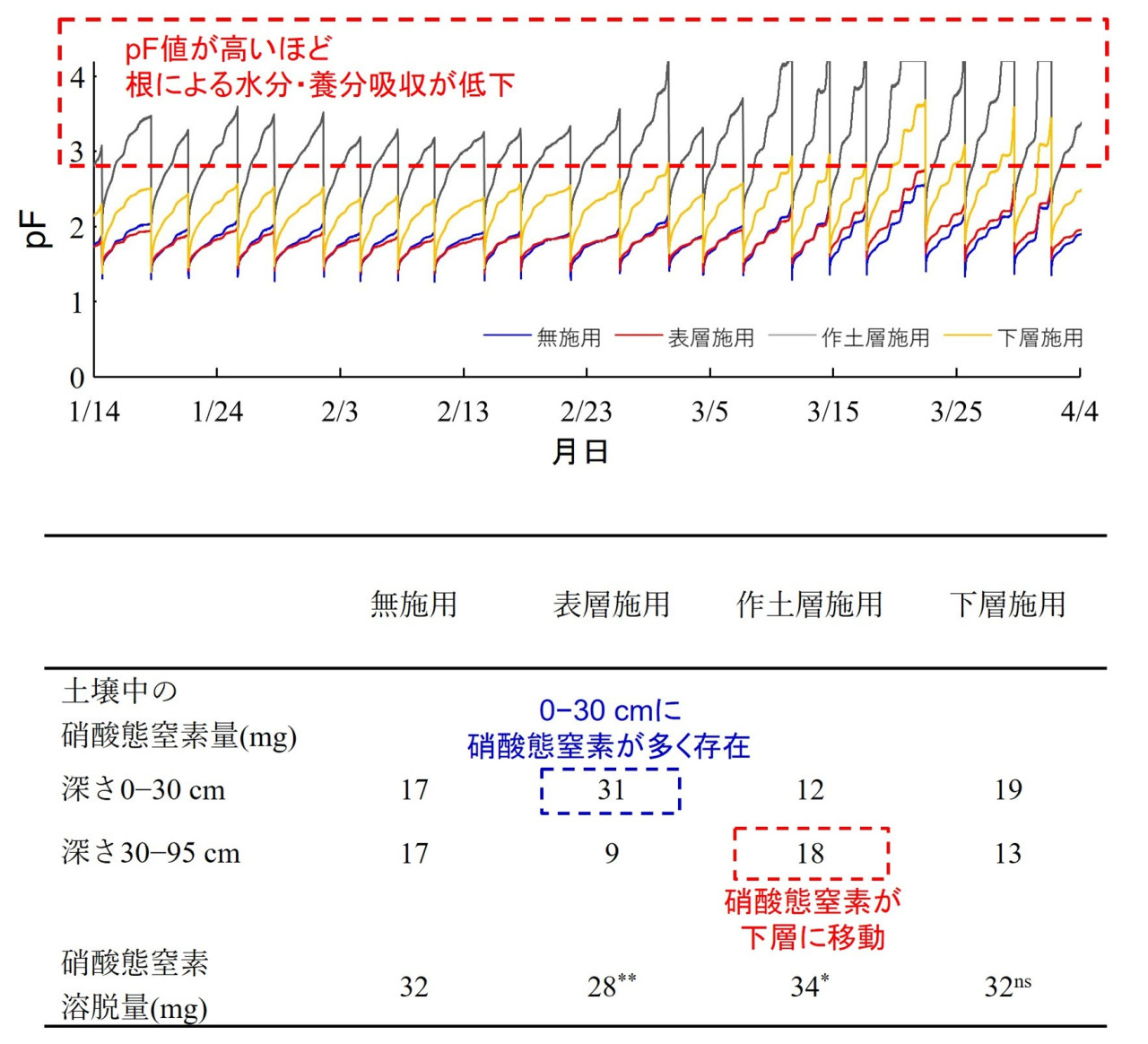研究成果
Optimization of Biochar Application Depth Contributes to the Reduction of Nitrogen Leaching
-Pathway to sustainable agriculture by suppressing nitrogen leaching through surface application-
Optimization of Biochar Application Depth Contributes to the Reduction of Nitrogen Leaching
―Pathway to sustainable agriculture by suppressing nitrogen leaching through surface application―
|
Main Points:
|
Overview
Using a pipe device developed by JIRCAS to precisely observe nitrogen dynamics in soil, the impact of the biochar application depth on nitrogen leaching was clarified at the Tropical Agriculture Research Front (Ishigaki City). This study addresses the environmental burden caused by excessive nitrogen fertilizer use and is an important step towards achieving sustainable agriculture.
The experiment was conducted using "Kunigami Mahji," a typical acidic soil of Okinawa. Soil was filled into pipes with a diameter of 20 cm and a depth of 95 cm, and biochar application conditions were set as no application, surface application (0-5 cm), plow layer application (0-30 cm), and subsoil application (25-30 cm). Nitrogen fertilizer was applied, and surface irrigation was performed under each condition, measuring nitrogen leaching from the bottom of the pipes.
Results revealed significant differences in nitrogen leaching depending on biochar application depth. Surface applications (0-5 cm) resulted in a 12.3% reduction in nitrate leaching compared to no application, showing a significant effect on reducing nitrogen leaching. However, plow layer application (0-30 cm) resulted in a 6.4% increase in nitrate and a 164.1% increase in ammonium nitrogen, demonstrating clear differences based on depth.
These findings indicate that biochar application depth affects soil nitrogen adsorption capacity and crop drought stress, influencing nitrogen leaching. Particularly with surface application, increased nitrogen adsorption in root zone soil and reduced drought stress were observed compared to no application. This study suggests that even with the same amount of biochar, selecting the appropriate depth can maximize the effect of reducing nitrogen leaching.
Based on these findings, we aim to develop technologies that reduce environmental impact and nitrogen fertilizer use while achieving more resilient and sustainable agriculture and contributing to restoring the balance of the global nitrogen cycle.
This study was published in the electronic edition of the journal Scientific Reports on October 1, 2024 (Japan time).
Publication
- Authors
- K Hamada, S Nakamura, D Kuniyoshi
- Title
- Pipe experiment elucidates biochar application depth affects nitrogen leaching under crop present condition
- Journal
- Scientific Reports
DOI: https://doi.org/10.1038/s41598-024-73621-3
For Inquiries
- JIRCAS President: KOYAMA Osamu
Program Director:- HAYASHI Keiichi (Environment)
- Principal Investigators:
- HAMADA Kosuke (Tropical Agriculture Research Front)
- NAKAMURA Satoshi (Crop, Livestock and Environment Division)
- KUNIYOSHI Daichi (Tropical Agriculture Research Front)
- Press Coordinator:
- OMORI Keisuke (Head, Information and Public Relations Office)
Press e-mail: koho-jircas@ml.affrc.go.jp
- OMORI Keisuke (Head, Information and Public Relations Office)
Figure 1: Pipe test
From January to April 2022, tests under four conditions (no application, surface application, plow layer application, subsoil application) were conducted in a glasshouse at the Tropical Agriculture Research Front. Each condition was repeated five times. The soil dry density is 1.25 g/cm³. The amount of biochar applied was the same for each condition, but the content rate varies depending on the application condition. In the figure, black indicates high biochar content, while gray indicates low biochar content.
Figure 3: Change in drought stress at 10-cm depth (top) and extract of nitrogen balance (bottom)
The values from soil moisture sensors installed in the pipes were converted to pF, a measure of the soil's water-holding capacity, by applying soil physical properties (water retention). Crops experience drought stress at pF 3 or higher, reducing water and nutrient absorption by roots. The amount of nitrogen adsorbed in the pipe soil was determined after the experiment, using soil samples taken from 0–30 cm and 30–95 cm depths. The symbols ** and * indicate significant differences compared to the no application condition (p<0.01 and p<0.05, respectively), while ns indicates no significant difference compared to the no application condition.



![図2 硝酸態窒素溶脱量(左)およびアンモニア態窒素溶脱量(右)の増加・減少率 左側: 硝酸態窒素溶脱の増加・減少率の表す棒グラフ、右側] アンモニア態窒素溶脱の増加・減少率を表す棒グラフ](/sites/default/files/202412/20241206.jpg)
